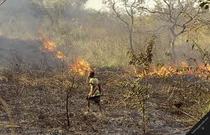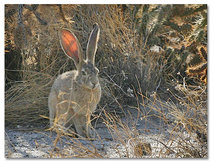Abstracto
El Sabana Tropical de Australia es un lugar muy
unico: tiene mucha variedad de plantas. Todas las plantas nativas son adaptadas
al fuego y los animales son chicos por la poca cantidad de agua que cae
anualmente. La majoridad son marsupiales. Pero a causa de la maltratacion de
los humanos, incluyendo el pastoreo y mineria, se esta degenerando el area.
Para preservar el ecosistema, se necesita controlar la populacion de ganado y minimizar
el la mineria y el tourismo.
Introduction  |
| Source: http://www.savannaalliance.org/about Map of Australia- the dark orange area represents the tropical savanna biome.
|
Introduction:
A biome with year-long warm temperatures, the tropical
savanna, also known as a tropical grassland, is characterized by tall grasses
and few shrubs. Tropical savannas cover 12% of the world’s land (2) and 1,250 miles of Australia (11). These ecosystems receive little rain,
approximately 50-100cm annually, and the plants are adapted to fire. The tropical
savanna of Australia provides a home for marsupials, reptiles, small mammals,
and Aboriginal, or indigenous, people.
 |
Picture from http://bioexpedition.com/savanna-biome/ illustrates what a Savanna should look like.
|
Australia was originally part of a huge continent
called Gondwanaland approximately 100 million years ago. (3) When Australia
broke apart, large dinosaurs began to disappear and Australia was eventually
inhabited by animals such as wolf-like thylacines, cow-sized herbivores, like
marsupial lions, and carnivorous kangaroos. At that time, Australia was mostly
rainforests, but around 15 million years ago the climate gradually began to dry
and cool as Australia drifted northward. As the continent dried out and fire
became more frequent, some rainforests were replaced by savannas. Many
rainforest mammals became extinct due to their inability to adapt to the savanna
environment. Between 40,000 and 2 million years ago, Australian savannas had a
large diversity of mega fauna, much as 3 meter tall kangaroos, giant goannas,
and many giant marsupial herbivores. About 40,000 years ago, all of Australia’s
mega fauna weighting more than 100 kilograms became extinct. (1)
Due to Australia’s long history of evolution,
savannas have high species richness, including many types of grasses, shrubs,
and some trees. These tropical savannas have many miles of uninterrupted
grasslands and woodlands that contain a large diversity of plants. One small
patch of woodland may contain a dozen different types of plants. Plants in
savannas are adapted to long dry seasons and fire. They are very good at
conserving moisture and many become deciduous during dry seasons. (8)
Human Impacts
 |
| http://www.savanna.org.au/all/fire.html Grazing in the Savanna. |
|
“Relationship between fire intensity (kWm−1; x-axis)
and tree survival (%; y-axis) for individual fire plots over the period
1990–95. (a) Survival vs maximum fire intensity. (b) survival vs average fire
intensity. The upper line in each figure refers to whole tree survival (◆); the lower to stem survival (▪).”
This graph shows that trees have a lower chance of
survival when there are no fires and when the intensity of the fire is
extensive.
|
 |
| http://thebiomesavanna.weebly.com/effects-of-human-progress.html Man-made fires in the Savanna. |
| In order for animals to graze year round, natural fires that build up in savannas must be suppressed. The suppressed fire builds up, which eventually produces uncontrollable forest fires that kill humans, crops, and animals. On the other hand, the savanna is burned too much by humans. Some plants that are not fire resistant burn, endangering their species. |
 |
| http://thebiomesavanna.weebly.com/effects-of-human-progress.html The rabbit is an invasive species to the Australian Savanna which threatens native species. |
Occasionally, non-native species are introduced to
the tropical savannas because of their usefulness in agriculture or otherwise,
but their introduction into other ecosystems endanger native plants. For
instance, the rabbit was introduced to Australia, but it reproduced so rapidly
that many grassland plants became extinct as a result (6). In a study of the effects of invasive grasses, researchers tested the possibility that a particular invasive grass, Andropogon gayanus, a grass from Africa, can increase fuel loads. By observing fires from two areas that have different densities of invasive grasses, including A. gayanus, researchers concluded that that A. gayanus can alter vegetation structure and increase intensity of fires (9).
The tropical savanna region of Australia is inhabited by Aboriginal communities, but the population density of this area is relatively low (carbon accounting). Aboriginal people of Australia are indigenous people who still practice hunter-gatherer techniques and pose little threat to the biome (6).
The building of mining infrastructures causes
destruction and fragmentation of habitats in tropical savannas (7).
As a result of all these human impacts, the global
conservation status of tropical savannas is bad. However, the local impacts of
the Australian savanna are minimal.
Benefits
Rangeland for cattle
Mining- Tropical Savannas in Australia has a large
abundance of natural resources, including petroleum, diamonds, and many types
of metals.
Army training- The Australian Defense Forces are
using tropical savannas as a training ground.
Tourism – High levels of biodiversity and the rich
culture of the Aboriginal people attract many tourists. (3)
Future Prospects
If plans to increase agricultural production in
tropical savanna regions are executed, the land and ecosystem that live in the
area will be threatened.
Tourism increase will result in addition of roads.
Mining, fires, and grazing will be detrimental to
the savanna’s landscape.
Invasive species will endanger various native
species.
What can be done?
1) Reversing degradation of land by limiting livestock
grazing.
2) Control population growth in order to reduce
livestock grazing.
3) During an unplanned burning in an area that had been
unburned for 7 years, the stems died compared to prescribed annual fires in
which stems survive. This study suggests, that instead of allowing crown fires,
humans should light fires in the savanna to ensure the survival of plants (4). However both have been proven to be damaging on vegetation and should
be used with caution (5).
4) Preserve land as a rich biodiversity hotspot.
5) Minimize land used for mining and tourism.
6) Stop introduction of non-native species into the area.
5) Minimize land used for mining and tourism.
6) Stop introduction of non-native species into the area.
 |
| http://biologyprojectwiki.wikispaces.com/Savanna+Biome+Per4 This is what the Australian looks like today; they are well-preserved. |
Works Cited
1. "Australian tropical savannas through time."
Savanna Explorer. N.p., n.d. Web. 21 Nov. 2013.
http://www.savanna.org.au/all/evolution.html
http://www.savanna.org.au/all/evolution.html
2.
Carter, J., G.D. Cook, G.A. Duff, S.L. Farrer, R.J. Williams, and J.C.Z.
Woinarski. “Carbon accounting, land management, science and policy uncertainty
in Australian savanna landscapes: introduction and overview.” Australian Journal of Botany (2005):
583-588. CSIRO Publishing. Web. 21 Nov. 2013. http://www.southwestnrm.org.au/sites/default/files/uploads/ihub/williams-rj-etal-2005carbon-accounting-land-management-scie.pdf
3.
Childs, John. “Australia’s Tropical Savannas.” Australian Savanna CRC. 2001. Cdu.edu. 21 Nov. 2013. http://savanna.cdu.edu.au/downloads/intro.pdf
4.
Cook, G.D., A.M. Gill, P.H.R. Moore, and R.J. Williams. "Fire Regime, Fire
Intensity and Tree Survival in a Tropical Savanna in Northern Australia." Australian Journal of Ecology (1999):
50-59.Wiley Online Library. Web. 18 Nov. 2013. http://onlinelibrary.wiley.com/doi/10.1046/j.1442-9993.1999.00946.x/full
5.
Coughenour, Michael B., Rodd Dyer, Adam C. Liedloff, and John A. Ludwig.
“Modelling the trade-off between fire and grazing in a tropical savanna
landscape, northern Australia.” Environmental
International (2001): 173-180. Science Direct. Web. 21 Nov. 2013. http://www.sciencedirect.com/science/article/pii/S0160412001000794
6.
"Effects of Human Progress - Biome: Savanna." Biome: Savanna. N.p.,
n.d. Web. 18 Nov. 2013. http://thebiomesavanna.weebly.com/effects-of-human-progress.html
7.
"Australia Places We Protect: Northern Grasslands." The Nature Conservancy. The Nature Conservancy. Web. 21 Nov 2013. http://www.nature.org/ourinitiatives/regions/australia/placesweprotect/northern-australian-grasslands.xml.
8. "Plants of the Savannas." Savanna
Explorer. N.p., n.d. Web. 21 Nov. 2013.
http://www.savanna.org.au/all/plants.html
http://www.savanna.org.au/all/plants.html
9.
Rossiter, Natalie A., et al. "Testing the grass‐fire cycle: alien grass
invasion in the tropical savannas of northern Australia." Diversity and
Distributions 9.3 (2003): 169-176. Web.21 Nov. 2013. http://onlinelibrary.wiley.com/doi/10.1046/j.1472-4642.2003.00020.x/full
10.
Skarpe, Christina. “Impact of Grazing in Savanna Ecosystems.” Ambio (1991): 351-356. JSTOR. Web. 21
Nov. 2013. http://www.jstor.org/stable/4313864?seq=6 .
11.
Taylor, Rob. "Australia Holds the World's Last Great Savanna."
Reuters. Thomson Reuters, 14 Aug. 2007. Web. 21 Nov. 2013. http://www.reuters.com/article/2007/08/14/us-australia-savanna-idUSSYD27009120070814

introduce certain species to stop fire infernos to save native species
ReplyDeletehttps://www.abc.net.au/science/articles/2012/02/02/3420810.htm